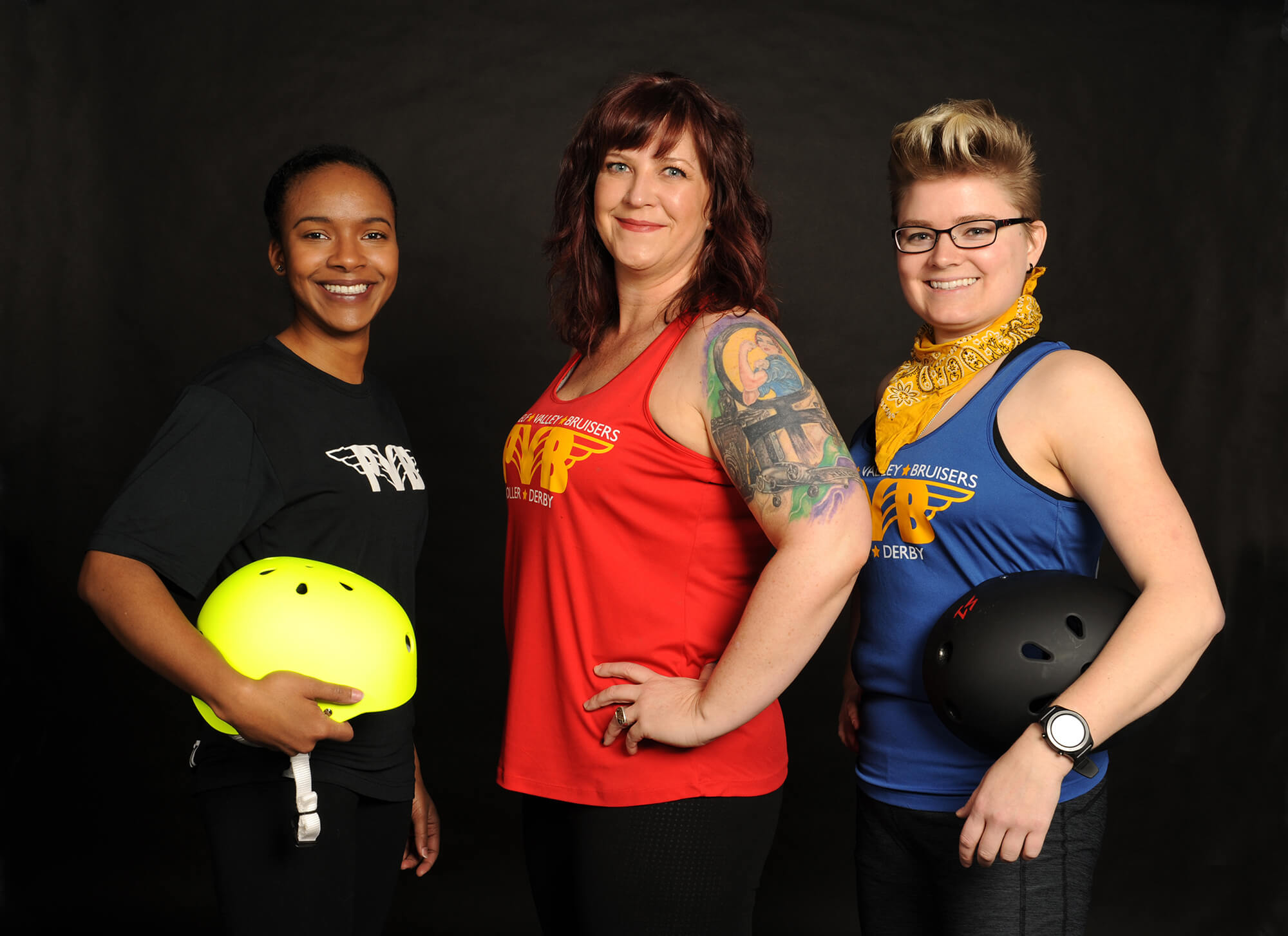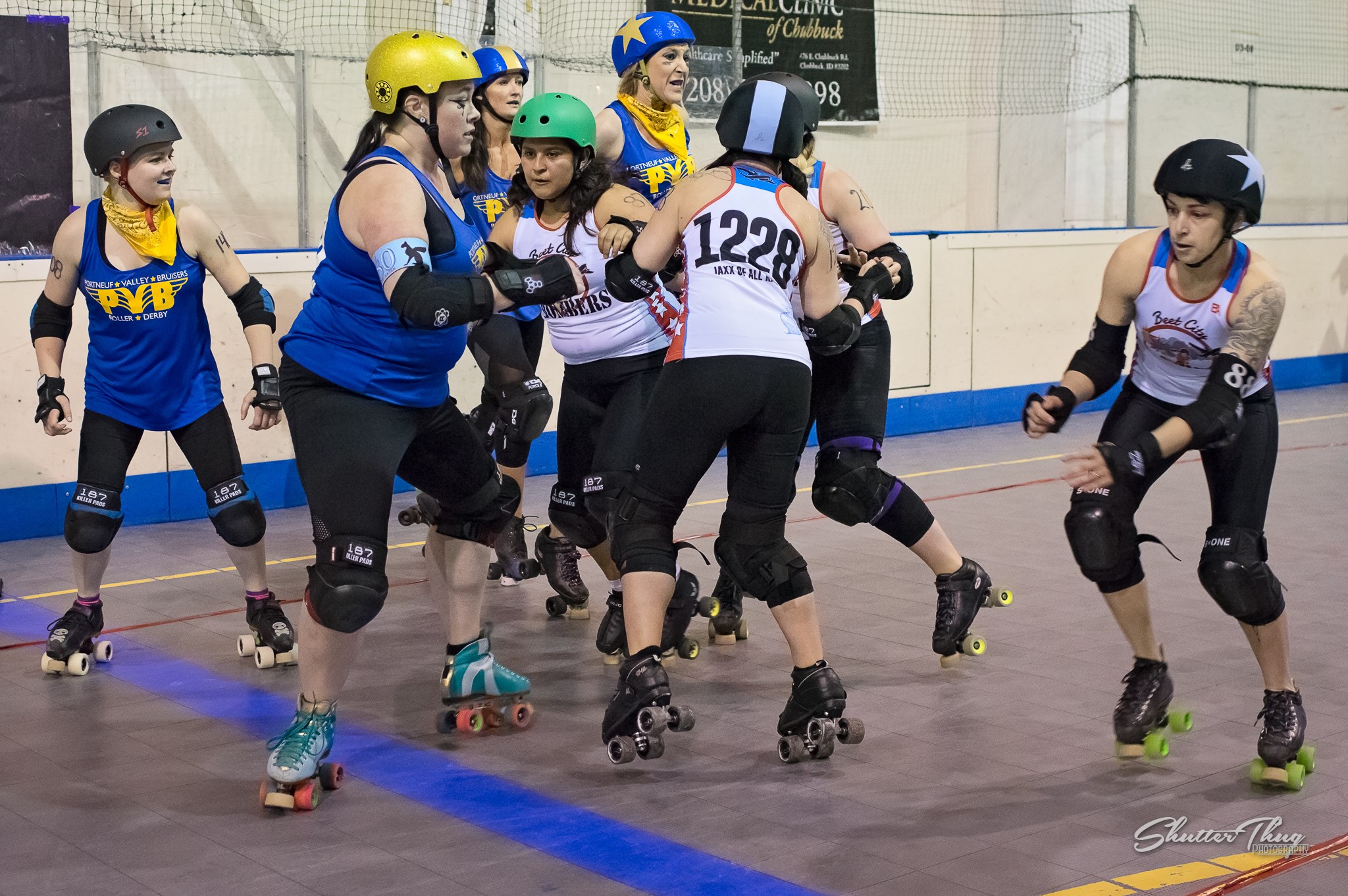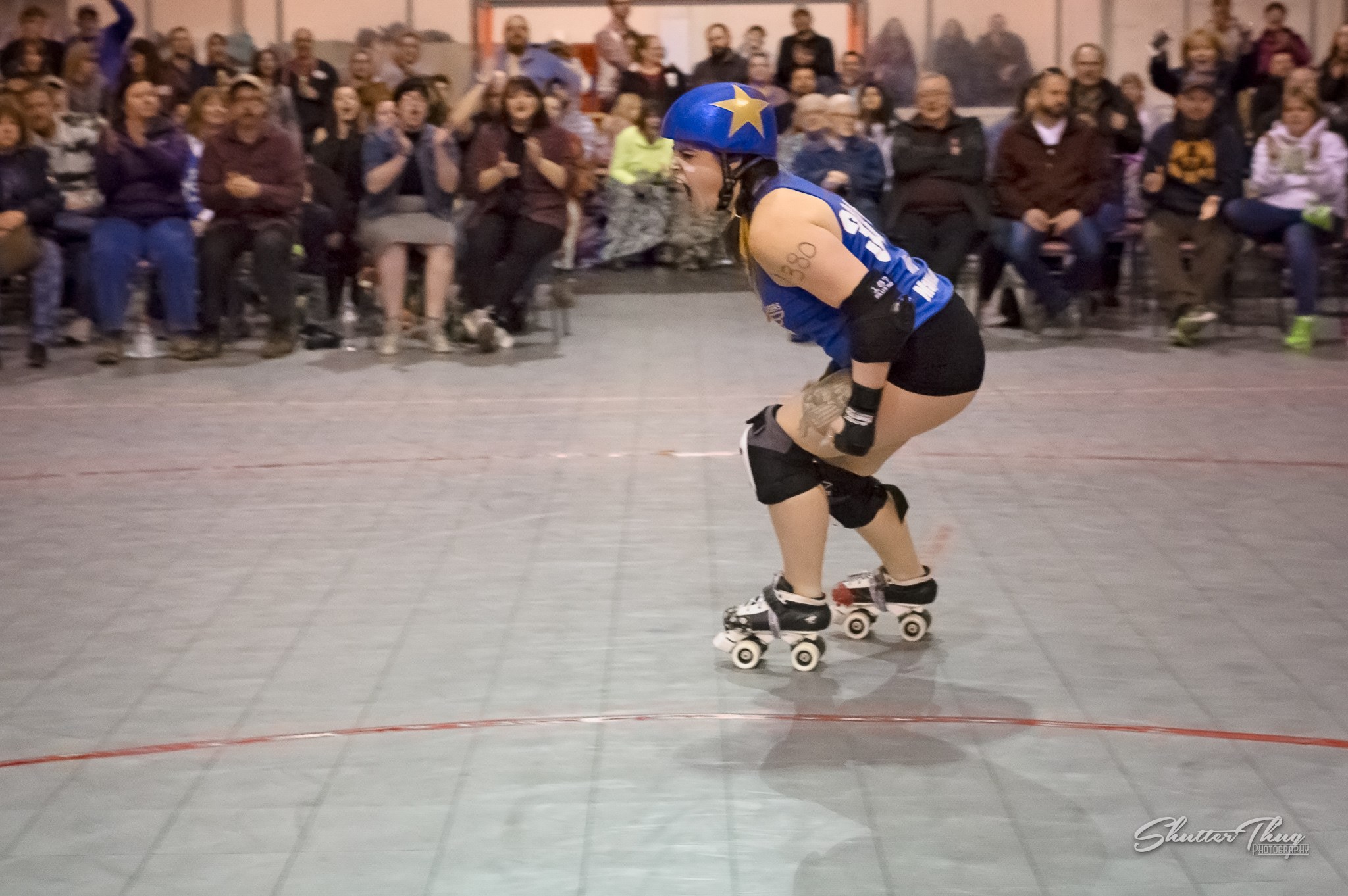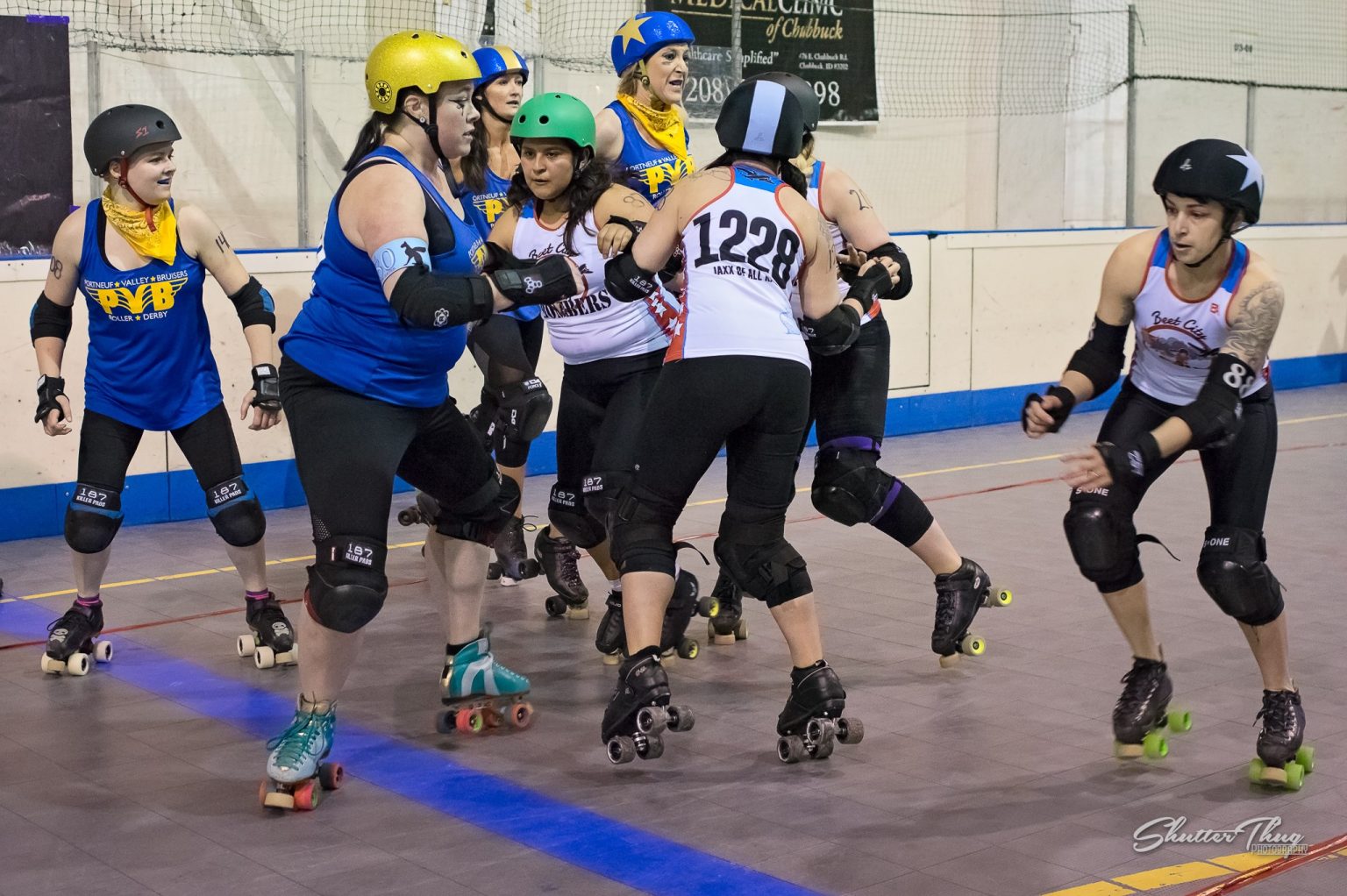“Assault E. Hag” … “Pitbullrabbit” … “CJ McKillHer” … These are not names typically found on Idaho National Laboratory identification badges, just the alter egos of three women who have embraced the age-old joys of roller derby.
Mild-mannered INL employees during the workweek, Emilee Harris, Jada Williams and Carmen McKellar have developed a passion for hip checks and big hits as members of the Portneuf Valley Bruisers, southeastern Idaho’s lone roller derby team.

They’re not the first to have gotten the bug, nor are they likely to be the last. In fact, they’re eager to hear from any co-worker or community members who might be interested. Although the rough-and-tumble image is a big part of their appeal, Harris is keen to point out there’s more to them than that. “We’re a not-for-profit, skater-managed, amateur sports league,” she said. “We want to make a positive impact on our members and the community.” At the beginning of April, for instance, they sponsored an all-day American Red Cross blood drive in Pocatello.
Right now, the Bruisers have a roster of about a dozen skaters. “We need more people, always,” said Harris. “A 20-plus-person bench would be awesome. We’re always looking for people, skating and nonskating, that are interested in joining our league.”
The Bruisers are a member of the Women’s Flat Track Derby Association, the international governing body for the sport of women’s flat track roller derby that sets standards for rules, safety, and rankings. Both WFTDA and the Bruisers promote diversity, pushing a message that they are open to all people regardless of socioeconomic status, gender, sexuality, race, ethnicity, ability, culture, or language.
Harris, who develops training programs in INL’s National & Homeland Security Directorate, joined in 2013 after following the Bruisers’ exploits for a few years (the team was founded in 2010). “It got to a point where I thought, ‘What am I waiting for?’” she said. “I showed up and they taught me how to play.”

McKellar, a video producer for INL’s Training Department, and Williams, a systems engineer in the Energy and Environment Science & Technology Directorate, both joined the team in 2017. Their experience started with a six-week skate camp, hosted and coached by the Bruisers, that covers new skills each week.
McKellar said when she came to work the Monday after her first “bout” her co-workers asked, “What happened to you?” Still, they shrugged it off when she told them what she’d been up to.
“There’s been broken bones, bruises and concussions,” she said. As cool as she may sound about it, her first time on the track was something she’ll never forget. “It was terrifying,” she said. “I was thinking, ‘I’ve just gotta survive.’ You’ve got these big mean girls coming at you and it’s intense.”
Williams has been in scrimmages at the Bruisers’ practices, which are held at Pocatello’s H&R Inline Hockey Rink. She has some experience with taekwondo, so taking a well-aimed blow won’t be a problem. “I like organized fighting, just not street fighting,” she said.
Before anyone skates in a WFTDA-sanctioned bout, they have to pass a minimum skills evaluation each year.
The Bruisers had bouts earlier this year against the Beet City Bombers (from Nampa), the Bittersweet Bombshells (Rock Springs, Wyoming) and the Jackson Hole Juggernauts (aka the “Juggs”). The next is May 12 in Idaho Falls, at the Joe Marmo/Wayne Lehto Ice Arena in Tautphaus Park, skating against the Heart Mountain Wreck on Wheels (Cody, Wyoming). Another Idaho Falls bout is scheduled for June 9, a double-header featuring the Bruisers vs. the Juggernauts and the Portland-based Geritol Mafia vs. Idaho Wildfire, both co-ed teams. Check out their website or Facebook page to get tickets.

Harris said the teams they play are pretty well matched across the board. The Beet City Bombers and Jackson Hole Juggernauts are particularly competitive. While the play is aggressive, the camaraderie among teams is a big attraction. “Once you’re in derby, everyone’s your family. We all play hard against each and then enjoy an adult beverage after with each other,” she said.
While roller derby dates back to the roller skating marathons of the Great Depression, the tradition of women taking to the track with wild names, Day-Glo and fishnets dates back only to 2000, when an alternative musician in Austin, Texas, named Eduardo “Devil Dan” Policarpo pulled together what he hoped would be an edgy spectacle featuring “women with tattoos, Bettie Page haircuts and guts,” also clowns and bears on unicycles. Policarpo soon left town after a dispute over money, while the women he’d recruited ditched the bears and clowns and organized the first all-female banked-track league, the TXRD Lonestar Rollergirls. A splinter flat-track league, the Texas Rollergirls, also emerged.
The emergence of roller derby from what was once regarded as something on the same level as professional wrestling to a full-fledged amateur sport has not gone without notice in the academic world. A quick search on the internet turns up research articles, doctoral dissertations and master’s theses with such titles as “High Heels and Fast Wheels: Alternative Femininities in Neo-Burlesque and Flat-Track Roller Derby” (Natalie Marie Peluso, University of Connecticut) and “The Unladylike Ladies of Roller Derby?: How Spectators, Players and Derby Wives Do and Redo Gender and Heteronormativity in All-Female Roller Derby” (Megan Geneva Murray, University of York).
“Derby girls” are described as “super heroes” and “rock stars,” states the latter. “Their pseudonyms are believed to help them ‘transform’ once they take to the track. Roller derby is seen as providing a venue to showcase women’s strength and new conceptualizations of femininity and motherhood. … Even though derby has done much to expand gender expectations, these expectations have only been expanded; they are not diminished or eradicated. Despite this, through all-female roller derby, women are seen as acting in new, transformative ways.”
ROLLER DERBY RULES
Although banked-track play delivers heavier hits and more excitement, there’s construction and significant expense involved. With flat track, “all you need is a good surface and some tape,” Harris said.
Under WFTDA rules, a bout lasts for two 30-minute periods. Periods consist of a series of jams which can last up to two minutes. Each team has one jammer (the player who scores points and is recognizable because of the star worn on her helmet cover), one pivot (who communicates strategy to her teammates and has a stripe on her helmet cover) and three blockers.
A jam starts when the referee blows the whistle. This is the signal for the “pack” (all players except for the jammers) to begin moving around the track. The jammers are positioned 30 feet behind where the pivots begin. The jammers cannot start until the pack has already begun moving and the referee blows two short whistles, signaling their release. The two teams skate around a track, in the same direction, at the same time. The blockers and pivot attempt to prevent the other team’s jammer from breaking through, while also assisting their own jammer.
Points are scored for each player of the opposing team, passed after a jammer’s first lap through the pack. Players can use their shoulders, butts and hips to knock over other players or to slow them down. WFTDA rules prohibit elbowing, punching, and hair pulling.
The first jammer to pass through the pack legally becomes the “lead jammer.” Only the lead jammer can call off the jam, and they do so by touching their hips. They may choose to call off the jam for strategic reasons. For example, the lead jammer may choose to end the jam to prevent the opposing team from scoring.
Hobbies are fulfilling, and fulfilled people make more productive employees. Hobbies unearth hidden skills, alleviate stress, unite you with others, and improve quality of life — all things that will help you function better at work. See other stories about Idaho National Lab employees.







